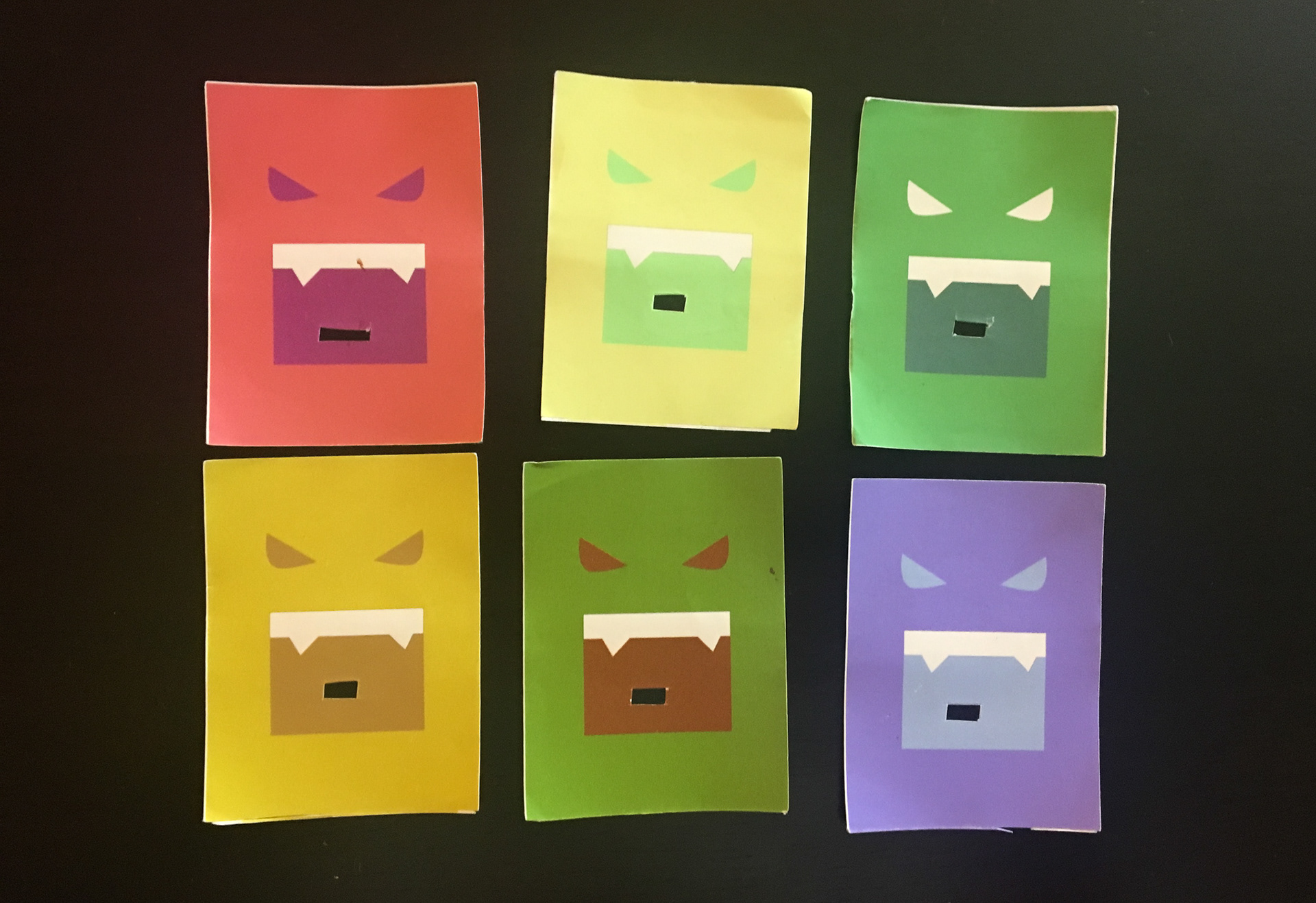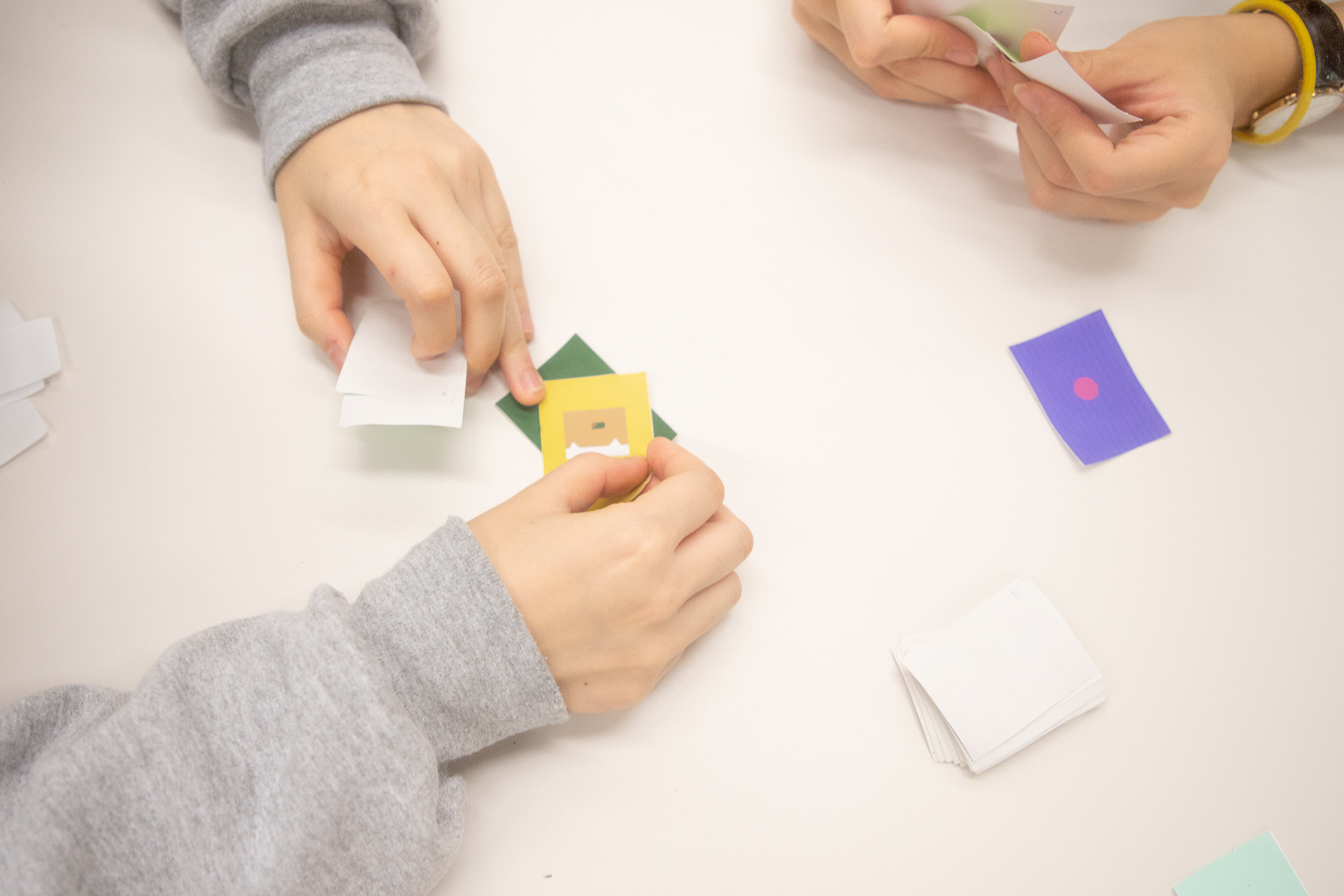Introduction
Duration: November 2017 (3 weeks)
My Role: Individual project
Tools: Adobe Indesign, Adobe Illustrator
Design Challenge
Demonstrate and help people understand Albers’ color principles clearly with the product. The product needs to naturally integrate at least one smoosh of two colors that appear to be the same but are in fact different, or vice versa.
Context
What are Albers’ color principles?
In his book Interaction of Color, Josef Albers pointed out that color is always seen in relationship with their surrounding colors.
Example from Interaction of Design by Josef Albers
Solution Overview
The final product is a multi-player card game called Feast of Albers. In the game, the player's goal is to find "Candy Cards" with the same color as the "Monster Card". The smooshes of colors happen when two cards overlay.
Peek into how the game works with 2 players
Design Process
Step 1: Research
1. Learned about Albers’ color principles.
2. Selected color pairs that can effectively demonstrate the principles.
Examples of color pairs selected
Step 2: Ideation Round 1
Defining user group: College students.
Why college students?
1. This product is a game with educational purpose (Albers' color principles)
2. Given the scope of this project, college students are the most accessible group for me to conduct testing.
Ideated possible ways to achieve the design goal through different media: a website, a booklet, a game, a video, and etc.
Sketch of a video idea
Left: Sketch of an online game idea / Right: Sketch of a website idea
Step 3: Sharing and Findings
Showed and told the idea sketches to different people for new perspectives.
Key findings:
1. Users are more interested in learning about the principles when given a product that allows interactions and practices.
2. The user experience can be heavily influenced by whether the smoosh of colors is naturally integrated.
Decision:
With the key findings in mind, I decided to proceed with designing a game.
Step 4: Ideation Round 2, Evaluation and Decisions
Ideated different types of the games.
Examples of game ideas. Left: a board game / Right: a phone game
Idea of a card game that evolved into the final product. Smoosh happens when the two cards overlay. (one of the card has a cut out)
At the end, I decided to proceed with the card game idea shown above.
Why this idea?
1. This multi-player game can lead to better user engagement: they can not only interact with the products, but also with other players.
2. The smoosh is well integrated: in the game, the ultimate goal of the players is to make the smoosh happen in every round by overlaying the correct cards.
Step 5: Prototyping
During this phase, I fleshed out the basic game components and mechanisms and made paper prototypes.
Game Components (shown below):
Left: Deck 1 with cut-out in the center color area
Middle: Deck 2 with color dots in the center
Right: Reward cards



Brief Introduction of Game Mechanism (rough draft)
1. Each player start with 5 reward cards and draws 5 cards
from Deck 2 'the dot deck'
from Deck 2 'the dot deck'
2. The players draw one card from Deck 1 ‘the cut-out deck' as a shared card
3. Each player selects 1 dot card out the 5 he has to pair with the shared cut-out card,
4. Each player declares that whether he thinks his dot card's color match with the shared cut-out card
5. Each player overlay his dot card with the cut-out card to see if the judgement is right.
6. Reward cards will be re-distributed based on the result.
Step Six: Testing and Revision
With the prototypes, I conducted testing with 2 groups of college students. With each group, I explained the rules with a hand-drawn instruction spreadsheet and asked the participants to play the game for 3 rounds.
Primary goals of the testing are:
1. Make sure the chosen color pairs can demonstrate the principles.
2. Test and refine the game mechanism.


Key Findings:
1. The chosen color pairs work well to demonstrate the principles.
2. Directions for game mechanism improvement:
-Design a very clear reward and punishment mechanism. It can be more competitive to incentivize the players.
-Consider adding a possible action that the players can win double rewards by taking higher risk.
-Reduce the number of the reward cards that each player has when the game starts to limit the length of each game.
-Set a clear standard of when a play wins or fails.
3. The original background story for the game is causing confusion. Need a better naming systems for each dock. Question Raised: how to efficiently communicate the game rules to new players?
Final Design: The Feast of Albers
1. Finalized, printed and cut out all the cards.
2. Revised the background story of the game and the game mechanism based on findings from the testings
3. Designed and printed an instruction sheet.
All Monster Cards
Front and Back of the card
All cards created
Instruction Sheet
Reflection and Future Action
General:
1. What is the value of the game once the players get too familiar to all the color pairs?
Potential Solutions: Consider moving the game to an digital platform so that the color pairs can be generated randomly.
2. What if the targeted users are not just college students? For example, what would the playing experience be for primary school children?
Game Mechanism:
What if people keep play safe during the entire game by picking out candy cards that are different from the monster card? Is the current reward & punishment system encouraging the players to take the risk?
Visuals:
1. The details of the monster cards can be more unified.
2. The back side of the monster cards should be different from that of the candy cards.